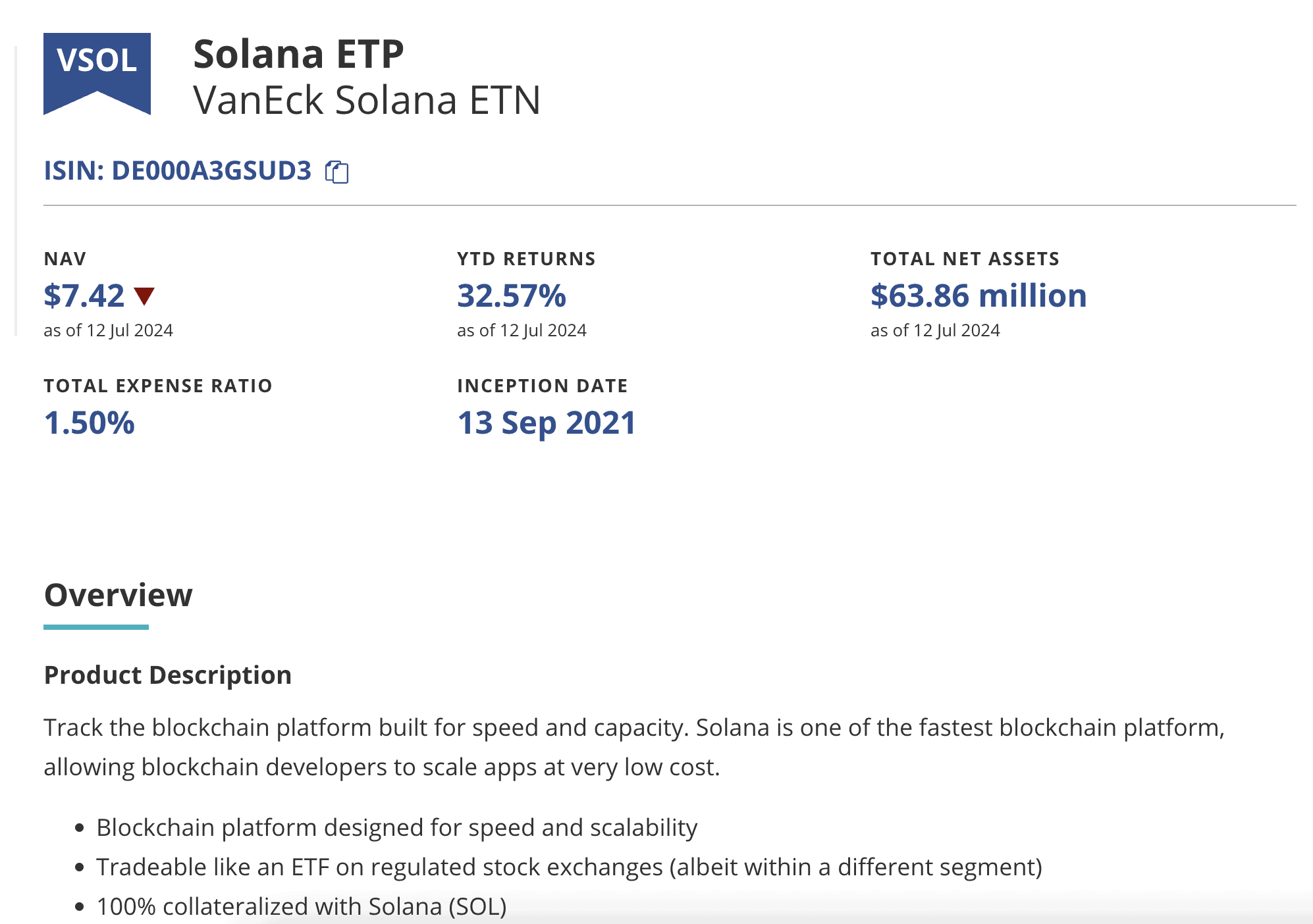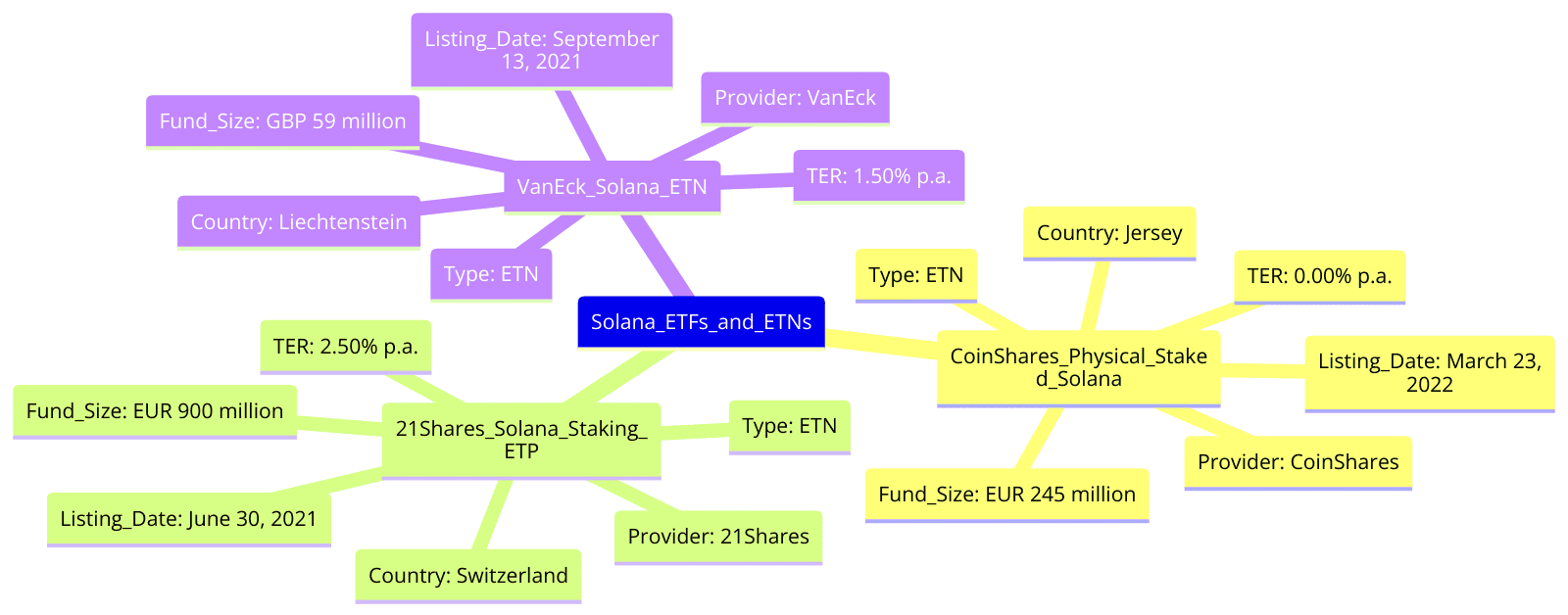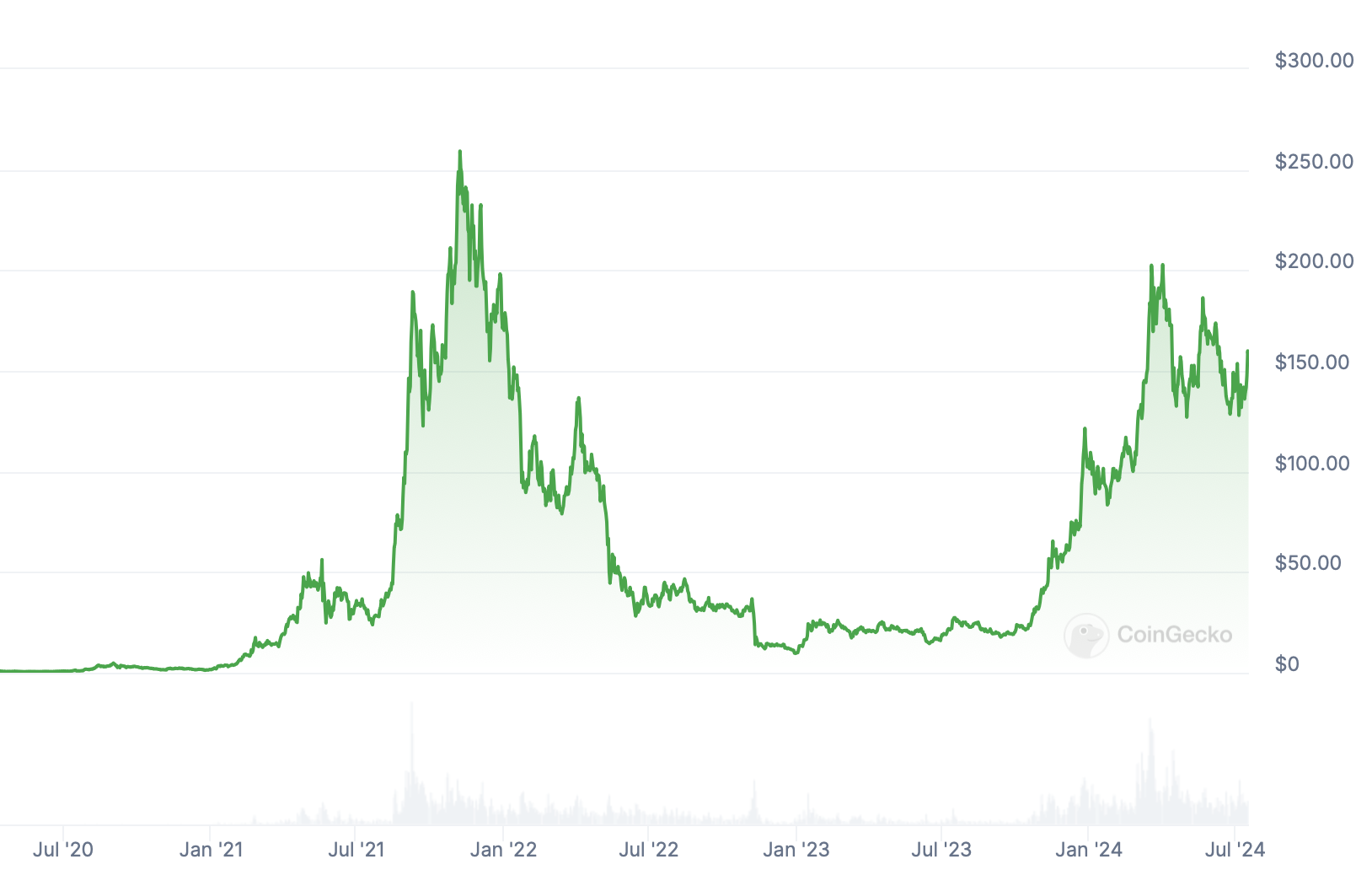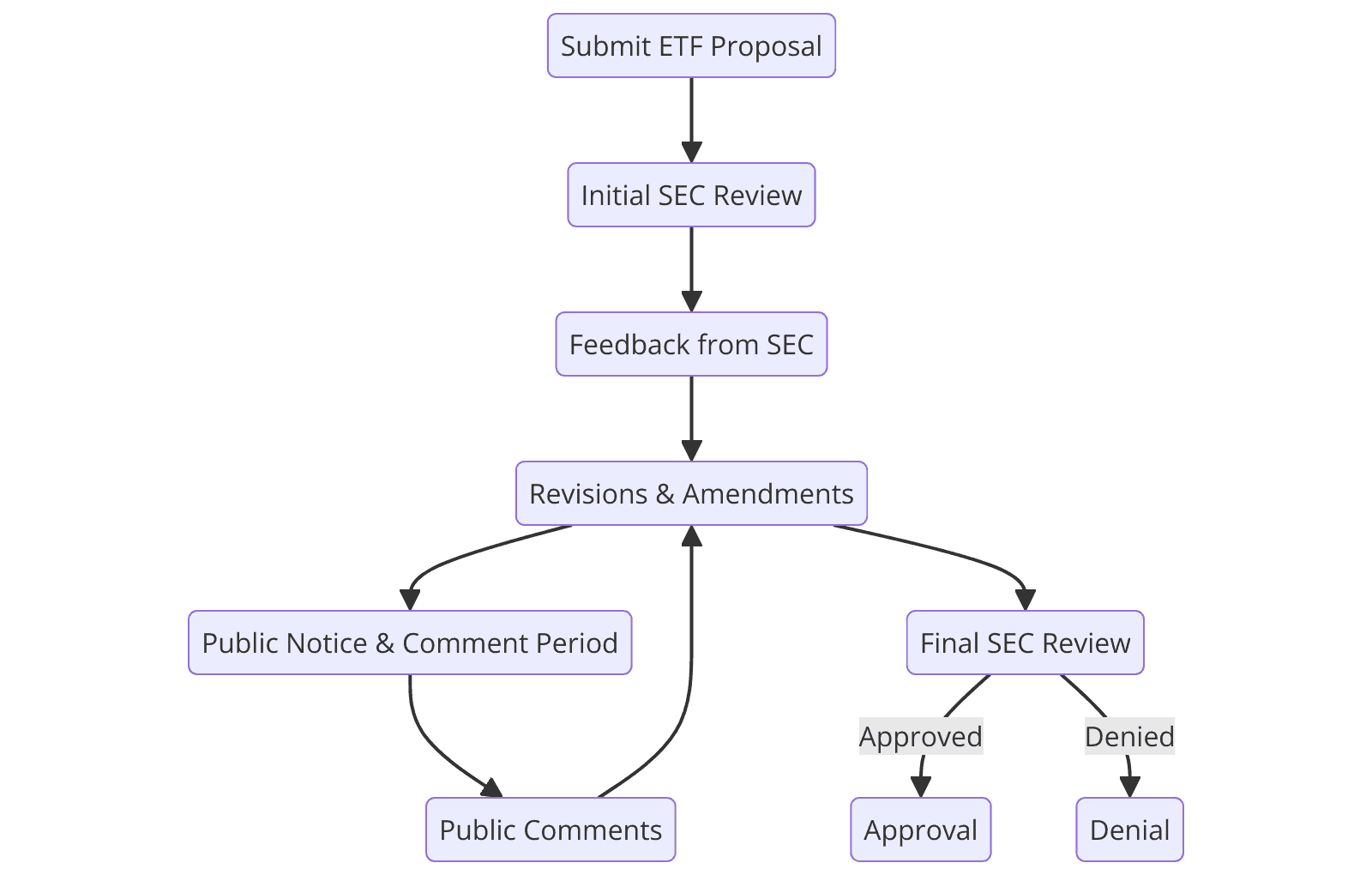The introduction of exchange-traded funds (ETFs) marks a significant step in the maturing crypto market. While much of the focus has been on BTC and ETH ETFs, the buzz is now extending to other assets, including Solana. This Solana ETF guide will walk you through the essentials of this emerging investment option, covering the top applicants, how Solana ETFs work, and the risks and potential benefits involved.
KEY TAKEAWAYS
•Solana ETFs offer a regulated way to invest in Solana, with both spot and futures options available for different investor needs.
•Major players like VanEck and 21Shares are leading the charge with Solana ETF filings, signaling strong institutional interest.
•Investing in globally-available Solana ETFs comes with risks, including market volatility and regulatory challenges, but also offers unique benefits like exposure to staking rewards.
- What are SOL ETFs, and how do they work?
- Types of Solana ETFs
- Solana ETF benefits
- Inception of Solana ETF discussions
- Solana ETF associated risks
- Solana vs. Ethereum ETFs
- Solana spot ETFs vs. Solana futures ETFs
- Solana ETFs vs. Bitcoin ETFs
- What does the future look like for Solana ETFs?
- Frequently asked questions
What are SOL ETFs, and how do they work?
Solana ETFs are standard investment funds that trade on stock exchanges. They aim to track SOL’s performance, giving investors an accessible and regulated way to gain exposure to the digital currency. This approach ensures that exposure to Solana becomes easy for institutional investors and individuals.
Notably, Solana ETFs fulfill all the four requirements associated with the Howey test — another reason they are to be classified as securities and subject to regulation by the SEC.
Trading mechanism
Solana ETFs are traded on traditional stock exchanges, such as the Toronto Stock Exchange. Investors can buy and sell shares of the ETF through their brokerage accounts. Notably, the ETF’s price fluctuates throughout the trading day based on market supply and demand. This provides high market liquidity, making it easier for investors to enter and exit positions compared to directly trading cryptocurrencies.
Creation and redemption: Solana ETF mechanics
Creating and managing a Solana ETF involves a series of well-defined steps designed to ensure transparency, liquidity, and regulatory compliance.
Here is how the entire flow reads: (Creation only)
- Initiation by APs or Authorized Participants: These are typically large financial institutions that are responsible for creating ETF shares.
- Basket deposit: The APs transfer Solana to the ETF’s custodian, an entity that securely holds the underlying assets.
- Issuance of ETF shares: In exchange for the deposited Solana, the ETF provider issues new shares of the ETF to the APs.
- Market introduction: The newly created ETF shares are then introduced to the market, where they can be traded on major stock exchanges like the Toronto Stock Exchange (TSX) or potentially the New York Stock Exchange (NYSE), depending on regulatory approval.
(Redemption only)
- Redemption request by APs: When APs want to redeem ETF shares, they submit a redemption request to the ETF provider.
- Returning ETF shares: The APs return the ETF shares to the provider, effectively removing these shares from the market.
- Asset transfer: In return for the ETF shares, the custodian releases the equivalent amount of Solana coins or assets back to the APs.
- Settlement: The redeemed Solana coins are transferred back to the APs, completing the redemption process.
The creation and redemption mechanism helps maintain the ETF’s price close to the net asset value (NAV) of the underlying Solana coins. It does this by allowing APs to create or redeem shares based on supply and demand dynamics.
Types of Solana ETFs
Just like Bitcoin and Ethereum ETFs, Solana ETFs can be segregated into:
- Solana spot ETFs: Instruments that mirror traditional Solana price movements.
- Solana futures ETFs: These ETFs invest in futures contracts based on Solana rather than holding the physical SOL. These have better chances of getting regulatory approval.
Major players dealing in Solana ETFs and ETNs
Here are some of the key players offering exposure to Solana, in some capacity, as an ETF or ETN:
3iQ Digital Asset Management (Canada)
- ETF: QSOL
- Exchange: Toronto Stock Exchange (TSX)
- Features: This is the first Solana ETF in North America. It tracks Solana’s price movements and offers staking yields.
VanEck (Germany)
- ETN: VanEck Solana ETN (VSOL)
- Exchange: Deutsche Börse
- Features: The ETN replicates the performance of the underlying Solana index with a collateralized debt obligation backed by Solana’s physical holdings. It is a physically backed ETN with a total expense ratio (TER) of 1.50% per annum.

WisdomTree (Jersey)
- ETN: WisdomTree Physical Solana (SOLW)
- Exchange: Various European exchanges, including Euronext Paris, XETRA, and SIX Swiss Exchange
- Features: This ETN is physically backed by Solana and has a TER of 0.50% per annum. It offers direct exposure to Solana’s price movements and is designed for long-term investment strategies.
21Shares (Switzerland)
- ETP: 21Shares Solana Staking ETP (ASOL)
- Exchange: SIX Swiss Exchange
- Features: This ETP is unique as it offers staking rewards in addition to tracking Solana’s price movements. It has a TER of 2.50% per annum and provides investors with the benefits of Solana staking without the need to manage the process themselves.

But that’s not all. A number of players have filed applications for Solana ETFs with the SEC. Here are the ones that you should know about:
VanEck
- Application: VanEck Solana ETF
- Details: VanEck submitted an S-1 form to the SEC for the VanEck Solana Trust, aiming to be the first U.S.-based Solana ETF.
21Shares
- Application: 21Shares Core Solana ETF
- Details: Following VanEck’s application, 21Shares also filed for a Solana ETF titled “21Shares Core Solana ETF.”
What’s up with the Grayscale Solana ETF?
Here are the important details regarding the Grayscale Solana ETF:
- Structure: Private Trust or Fund ETF
- Ticker: GSOL
- Exchange: OTC Markets
- Features: Provides exposure to Solana’s price movements without the need for direct purchase and storage of SOL.
- Regulatory status: Not registered under the Investment Company Act of 1940; hence, it does not require SEC approval as ETFs do.
- Target investors: Accredited investors initially, with secondary market trading available.

Also, there are a few similar products that are either trading or awaiting regulatory approval. These include:
Bitwise Asset Management
- Product: Bitwise 10 Crypto Index Fund (BITW)
- Nature: Private trust offering exposure to a basket of cryptocurrencies, including Solana.
Osprey Funds
- Product: Osprey Solana Trust (OSOL)
- Nature: Private trust providing exposure to Solana, traded on the OTCQX Market.
VanEck
- Application: VanEck Solana Trust (pending SEC approval)
- Nature: Aimed to be an ETF but currently filed as a trust.
That’s all there is about the current ETF/ETN landscape concerning Solana.
Latest development: On Aug. 7, 2024, Brazil’s Securities and Exchange Commission (CVM) approved the world’s first spot Solana ETF. The Solana ETF, developed by QR Asset Management and operated by Vortix, tracks the CME CF Solana Dollar Reference Rate, ensuring a standardized and reliable price quote for Solana. Although the ETF has received regulatory approval, it is still in the pre-operational phase, awaiting final approval from Brazil’s main stock exchange, B3.
Solana ETF benefits
Some of the top benefits associated with investing in Solana ETFs include:
- Diversification
- Liquidity
- Regulatory oversight
- Access to staking rewards for some ETFs/ETNs
- Accessibility
- Low fees as users need not worry about wallet setup, exchange fees, and other factors.
Inception of Solana ETF discussions
Solana has been around for a while now. The network has overcome many challenges, including when, in late 2022, the FTX contagion surfaced. Solana was on the brink of virtual elimination, with SOL prices dropping to single digits. Critics and skeptics were quick to proclaim the potential end of Solana.
Did you know? Solana was founded in 2017 by Anatoly Yakovenko, a former Qualcomm engineer, and launched its mainnet in March 2020.
Despite the challenges, the core team remained. Throughout 2023 and 2024, Solana grew in terms of price action and TVL, restoring confidence in the network’s utility. Notably, the recovery wasn’t only about the price but also about adoption and market perception.

Solana ETFs are yet to get U.S approval. Yet their global presence, including across the Toronto Stock Exchange and Deutsche Borse, has birthed numerous discussions around this potential. Here are some of the other factors pertaining to Solana that have contributed to the ETF momentum:
- Technical strengths and the rise of meme coins are specific to the Solana network.
- Institutional interest, with Canada’s 3iQ Solana ETF being one of the validations of these factors
- Positive price predictions, led by key analysts, with some even projecting that SOL will breach past $500 in the less-than-distant future
- Strategic partnerships with big names such as Circle have injected $250 million worth of USDC into the Solana ecosystem. This has significantly boosted its liquidity while demonstrating strong institutional confidence.
- Constant expansion with over 400 active projects thriving in the ecosystem
All these factors have contributed to the positive ETF momentum surrounding Solana. In late June 2024, the first filing applications were made for Solana ETFs.
Sponsored Sponsored“Love seeing the markets up like this. ETH ETF incoming Solana ETF following shortly behind. Be prepared for September.”
Burns, Co-Founder of D3fenders: X

Solana ETF associated risks
Yes, even Solana ETFs are prone to risk. The most critical are:
- Regulatory risks, courtesy of the changing environment and perception toward cryptocurrency
- Market volatility, which might impact spot and futures ETFs
- Technological risks
- Liquidity risks
- Custody risks as ETF custodians might end up experiencing hacks.
- Competitive risks
Solana vs. Ethereum ETFs
Here is a quick table highlighting the differences between Solana and Ethereum ETFs:
| Feature | Solana ETF | Ethereum ETF |
| Primary objective | Track Solana (SOL) price movements and staking yields | Track Ethereum (ETH) price movements and potential staking rewards |
| Regulatory status | Pending SEC approval for some ETFs; others like Grayscale Solana Trust, available as private trusts | Some ETFs have already been approved by the SEC, and more are in the pipeline. Awaiting trading approval. |
| Market adoption | Rapidly growing interest, particularly in high-speed applications, meme coins, and DeFi | Established market presence with extensive use in smart contracts and DeFi |
| Underlying assets | Solana (SOL) or Solana futures contracts | Ethereum (ETH) or Ethereum futures contracts |
| Performance metrics | High throughput and low transaction fees influence ETF attractiveness | Ongoing upgrades (Ethereum 2.0) aim to improve scalability and reduce fees |
| Risk factors | Market volatility, regulatory changes, technological risks | Market volatility, regulatory changes, transition risks (Ethereum 2.0) |
| Investor profile | Suitable for investors seeking high-performance and innovative technology exposure | Ideal for investors looking for stability in a mature blockchain ecosystem |
Do note that this table focuses solely on the ETF-specific differences instead of discussing Solana and Ethereum as blockchains.
Solana spot ETFs vs. Solana futures ETFs
It’s often easy to confuse spot and futures crypto ETFs. Here’s a table that outlines the differences between the two ETF categories.
| Feature | Solana spot ETF | Solana futures ETF |
| Underlying assets | Directly holds Solana (SOL) coins | Holds futures contracts based on Solana |
| Price tracking | Tracks the actual price of Solana | Tracks the expected future price of Solana |
| Exposure | Provides direct exposure to Solana’s market performance | Provides exposure to Solana’s future price movements |
| Investment strategy | Suitable for long-term investors seeking actual asset ownership | Suitable for short-term traders and speculators |
| Volatility | Lower volatility due to direct asset holding | Higher volatility due to futures contracts and leverage |
| Risk factors | Market volatility, regulatory changes, custody risks | Market volatility, regulatory changes, rollover risk, leverage |
| Liquidity | Generally higher liquidity due to direct asset holding | Potentially lower liquidity depends on futures market conditions |
| Costs | Lower costs associated with holding actual assets | Higher costs due to contract rollovers and leverage |
Solana ETFs vs. Bitcoin ETFs
How does a Solana ETF compare to a Bitcoin ETF? First, the BTC ETF was the first crypto ETF to be approved in the U.S. While both have risk, Bitcoin ETFs do not have staking capabilities, unlike Solana ETFs.
Also, when comparing the investor profiles, it’s clear that Solana ETFs are suitable for investors seeking innovative technology, whereas Bitcoin ETFs are geared toward stability. However, both are meant to offer cryptocurrency investment opportunities to traditional players.
Note that while Blackrock has a spot in Bitcoin ETF, the firm is also trying to make strides in the Solana ETF space.
What does the future look like for Solana ETFs?
The future of Solana ETFs hinges heavily on the fate of the U.S. Presidential Elections in November 2024. However, as covered in this Solana ETF guide, market leaders like VanEck, 21Shares, and Blackrock have submitted or are planning to submit ETF applications. So, the expected approval of spot entities might not be distant. Notably, the approval process pertaining to a spot Solana ETF is expected to take several months, with the SEC having up to 240 days to make a decision in most cases.
Keep in mind that investing in any form of ETF carries risk. If Solana ETFs do get the green light, consider whether you are best suited to investing in an ETF or simply buying Solana. Ensure you employ a comprehensive risk management strategy regardless of the size of your investment. Never part with more funds than you can comfortably afford to lose.
Disclaimer: This article is for informational purposes only and does not constitute financial or investment advice. Always conduct your own research or consult with a professional before making any investment decisions.

